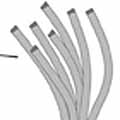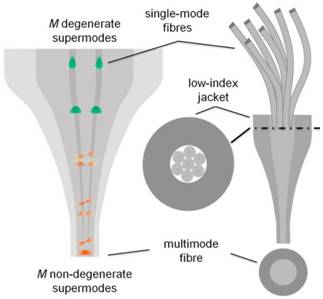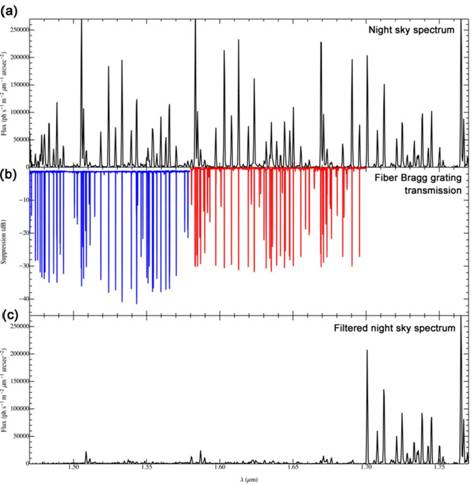Speciality Optical Fibers for Advanced Astronomical Instrumentation
Multimode fiber Bragg gratings enable enhancements to the sensitivity of night-sky spectral analysis, highlighting one novel functionality made possible by advancements in the field of astrophotonics.
22 July 2015, SPIE Newsroom. DOI: 10.1117/2.1201507.005980
 Fiber optics have been used in astronomical instruments since the early 1980s and have become a routine and powerful tool, allowing the simultaneous observation of hundreds of objects by transporting light from the focal plane of the telescope to a spectrograph. Similarly, single-mode fibers are used to combine the beams from separate telescopes coherently, enabling interferometric observations. There has recently been growing interest in applying novel types of fibers and waveguides that perform more complicated functions than the transport of light to astronomical instrumentation. The incorporation of photonics in astronomical instrumentation has become known as astrophotonics.1
Fiber optics have been used in astronomical instruments since the early 1980s and have become a routine and powerful tool, allowing the simultaneous observation of hundreds of objects by transporting light from the focal plane of the telescope to a spectrograph. Similarly, single-mode fibers are used to combine the beams from separate telescopes coherently, enabling interferometric observations. There has recently been growing interest in applying novel types of fibers and waveguides that perform more complicated functions than the transport of light to astronomical instrumentation. The incorporation of photonics in astronomical instrumentation has become known as astrophotonics.1
The filtering of atmospheric emission lines is one particular astronomical application that has benefitted from the implementation of photonics. At near-infrared wavelengths, the night sky is extremely bright and rapidly variable. This bright fluctuating emission leads to large Poisson and systematic noise, which cannot be easily subtracted from observations of astronomical objects. This fluctuating emission, which arises from the rotational and vibrational de-excitation of hydroxide (OH) molecules in the upper atmosphere, results in a forest of emission lines. Although this emission is very bright and the lines numerous, they are also intrinsically very narrow. If the lines could be selectively filtered, the near-infrared sky would be very dark. However, such a filter—capable of filtering scores of irregularly spaced narrow wavebands while maintaining good throughput between the lines—would need to be optically complex.
Fiber Bragg gratings (FBGs) offer a potential solution to this problem. These gratings are ‘written’ by exposing the fiber to an intense UV interference pattern, which creates a periodic variation in the refractive index of the core. As a result, they are capable of achieving very strong reflection channels over very narrow wavebands, meeting the precise requirements for filtering atmospheric OH lines. However, in order to use FBGs for this purpose, several challenges must be overcome. First, the gratings must work over a large bandpass (∼200nm) because different spectroscopic features need to be measured at a range of wavelengths. Second, since there are many bright OH lines in the wavelength region of interest, the gratings must have ∼100 reflection channels. However, splicing together many individual Bragg gratings, one for each line, would lead to unacceptable splice losses. Third, the gratings must be made to work in the multimode regime due to atmospheric turbulence, which distorts the incoming wavefronts and leads to poor coupling into single-mode fibers.
Fortunately, we have been able to overcome each of these challenges.2 We have developed FBGs with highly aperiodic refractive index changes in the core of the fibers that are capable of producing up to 150 strong (up to 30dB) and narrow (∼150pm) reflection channels over a 400nm bandpass.3, 4Remarkably, these reflection channels can be accurately matched to the OH lines, in regard to both wavelength and strength. The development of a device called the photonic lantern enables FBGs to be used with multimode fiber.5–7 These devices are made by enclosing a bundle of single-mode fibers in a low-refractive-index jacket: see Figure . The bundle is then drawn into a taper, such that the cladding of the single-mode fibers is fused together to form the core of a multimode fiber, and the low-index jacket becomes the cladding. If the taper is slow and adiabatic, this device can efficiently convert a multimode input into an array of single-mode fibers (and vice versa). The multichannel aperiodic FBGs (written in single-mode fibers) can thereby be spliced into the single-mode fibers of a photonic lantern, addressing all three of the above challenges.
Figure 1. The principle of operation of a photonic lantern. Single-mode fibers are inserted into a low-index jacket, and then tapered to form a multimode fiber, the core of which is the fused cladding of the single-mode fibers, and the jacket its cladding. As light propagates through the lantern, it evolves from M individually guided degenerate modes in the core of each single-mode fiber to M non-degenerate modes in the multimode output, where M is the number of single-mode fibers. Individual aperiodic fiber Bragg gratings (FBGs) can then be spliced to each single-mode fiber. (Figure reprinted with permission.2)
We tested these technologies in a prototype instrument called GNOSIS,8which filters 103 of the brightest OH doublets between 1.47 and 1.7μm. We have shown that the combination of FBGs and photonic lanterns are indeed able to cleanly remove the OH lines while leaving the interline region unaffected:9 see Figure 2. Although we have demonstrated the potential of FBGs for filtering the OH lines, GNOSIS does not improve the sensitivity of observations over existing instruments. This is because the FBGs and photonic lanterns were retrofitted to an existing spectrograph, leading to high thermal emission, low overall throughput, and relatively high detector noise. To overcome these issues, we are currently building a new spectrograph called PRAXIS, which is optimized for an OH-suppressed fiber feed.10
Figure 2. A summary of the results of our experiments to filter the atmospheric hydroxide (OH) emission lines from astronomical observations. (a) The spectrum of a blank patch of sky before filtering, dominated by bright emission lines from OH molecules in the upper atmosphere. These lines are unresolved in the spectrum and are intrinsically very narrow. (b) The transmission of our filters written into FBGs. The blue and red curves represent results from two separate gratings, each of which has ∼50 channels over a ∼100nm passband. The reflection channels are matched exactly to the OH lines. (c) The filtered sky spectrum, with all the lines between 1.47 and 1.7μm cleanly removed. λ: Wavelength.
We are also investigating ways to improve the efficiency of the OH suppression. GNOSIS requires 266 complex FBGs (one for each mode) to allow for a 1.2 arcsecond view of the sky. We independently manufactured each FBG and spliced them into the photonic lanterns. Scaling this technology to larger fields of view represents a challenging task, but a new method of making photonic lanterns from multicore fibers (i.e., many single-mode cores embedded in a common cladding)11 promises to simplify the inscription of the Bragg gratings. This technique enables the gratings to be printed into every individual core simultaneously. Indeed, we have recently demonstrated a multicore fiber with uniformly deep Bragg gratings printed into all seven cores.12
In summary, we have highlighted an example of the integration of photonics into astronomical instrumentation. Our work represents one area of a rapidly growing field including many different applications and platforms, such as array waveguide gratings, beam combination in integrated circuits, mode conversion, ring resonators, femtosecond direct-write waveguides, and Lippmann spectroscopy. Our research showcases some of the benefits and challenges inherent to the field of astrophotonics and highlights that adaptations to telecommunication devices must be made, especially with respect to the multimode regime. Work in this area will enable the development of photonic devices with functionalities that are unfeasible using traditional optics, such as the complex filters shown here, and could lead to many novel possibilities in astrophotonics. In the next stage of our research, we intend to build PRAXIS and to develop multicore FBGs capable of improving the sensitivity of GNOSIS.
The GNOSIS and PRAXIS instruments have been developed in collaboration between the Australian Astronomical Observatory; the Sydney Institute for Astronomy, University of Sydney; innoFSPEC, Leibniz-Institut für Astrophysik Potsdam; the Centre for Astrophysics and Supercomputing, Swinburne University of Technology; the Research School of Astronomy and Astrophysics, Australian National University; innoFSPEC, Institut für ChemiePhysikalische Chemie; and the University of New South Wales. We acknowledge the support of Australian Research Council (ARC) LIEF grant no. LE100100164, which supported the development of GNOSIS. PRAXIS has been funded through Bland-Hawthorn's ARC Federation and Laureate Fellowships.
(From: http://www.spie.org/x114928.xml?highlight=x2418&ArticleID=x114928)


